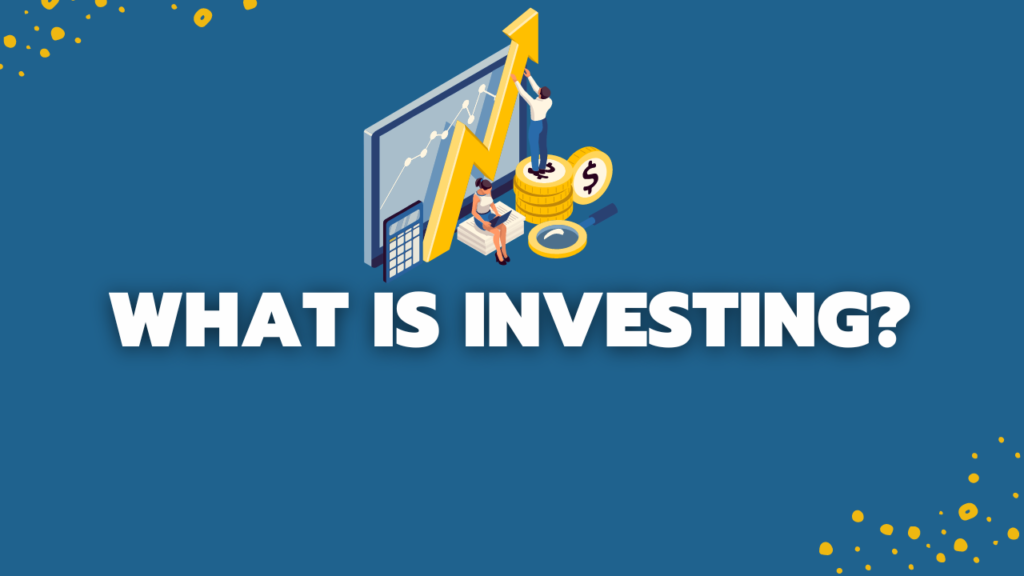What is Investing in simple terms?
Investing is the act of placing money into different assets with the hope of making a profit later on.
While it can be risky, investing is also an important tool for building wealth over time.
In this article, we’ll look at a variety of investments, points to consider before putting your money in, and how to get started.
4 Types of Investing
Stock Investing
Investing in stocks is purchasing and selling shares of publicly traded corporations. Although stocks are regarded as a high-risk investment, they also carry the possibility of high returns.
Here are some advantages and disadvantages of buying stocks:
Advantages:
- High potential returns
- Liquidity (stocks can be easily bought and sold)
- Diversification opportunities
Disadvantages:
- High risk
- Stock prices can be volatile
- No guarantee of returns
To be successful in stocks, consider these tips:
- Do your research before investing
- Diversify your portfolio
- Don’t try to time the market
Bond Investing
Bonds are a sort of fixed-income investment in which you put money into a company or government in exchange for monthly interest payments.
Here are some advantages and disadvantages of bond investing:
Advantages:
- Less risky than stocks
- Regular income stream
- Diversification opportunities
Disadvantages:
- Lower potential returns than stocks
- Can be affected by changes in interest rates
- Credit risk (the possibility of default by the issuer)
To be successful in bond investing, consider these tips:
- Understand the different types of bonds
- Evaluate the creditworthiness of the issuer
- Consider interest rate risk
Real Estate Investing
Real estate or property investment involves buying and managing properties for rental income or capital appreciation.
Here are some advantages and disadvantages of real estate investing:
Advantages:
- Potential for rental income and capital appreciation
- Diversification opportunities
- Tax benefits
Disadvantages:
- High entry costs
- Property management can be time-consuming
- Market risk (real estate prices can fluctuate)
To be successful in real estate investing, consider these tips:
- Understand the local real estate market
- Calculate the potential return on investment
- Be prepared for unexpected expenses
Alternative Investments
Alternative investments are non-traditional assets that can include hedge funds, private equity, commodities, and more.
Here are some advantages and disadvantages of alternative investments:
Advantages:
- Diversification opportunities
- Potential for high returns
- Low correlation with traditional assets
Disadvantages:
- High fees
- Limited liquidity
- Complex investment structures
To be successful in alternative investing, consider these tips:
- Understand the risks and potential returns
- Consider the fees and expenses
- Only invest in alternative investments with a reputable and experienced manager
Factors to Consider Before Investing

It is crucial to take into account a number of factors before investing to make sure that your investment aligns with your financial goals and risk tolerance.
A. Financial Goals
Your financial goals should be the foundation of your investment plan. Ask yourself what you hope to achieve through investing.
Are you putting money down for your retirement, a down payment on a house, or your child’s education?
Your financial goals will determine the investment strategies that are best suited for you.
B. Risk Tolerance
Risk tolerance is the level of risk you are willing to take on in your investments. Are you comfortable with high-risk, high-reward investments, or would you prefer low-risk, low-reward investments?
Your risk tolerance should also be aligned with your financial goals. If you’re investing for retirement, you may have a longer time horizon and be willing to take on more risk than if you’re saving for a short-term goal.
C. Time Horizon
Your time horizon is the length of time you plan to hold an investment before selling it. Your time horizon will determine the types of investments you choose.
If you have a long time horizon, you may be more comfortable with volatile investments like stocks that have the potential for high returns over the long term.
If you have a short time horizon, you may prefer less volatile investments like bonds or money market funds that are less likely to lose value.
D. Diversification
Diversification is when you spread your investments across different asset classes to reduce the risk of loss.
By diversifying your investments, you can minimize the impact of any one investment that poorly performing.
Diversification can be achieved by investing in a mix of stocks, bonds, real estate, and alternative investments.
E. Investment Costs
Investment costs are an important consideration when choosing investments. The costs can include management fees, trading fees, and expense ratios.
High investing fees can cut into your returns and lower the amount of money you earn over time.
Before making an investment decision, look at the expenses of several investing options.
Steps to Start Investing
Now that you’ve considered the factors that will impact your investment decisions, it’s time to take action.
A. Determine Investment Goals
Identify your financial goals and determine how much money you need to save to achieve them. Set a specific dollar amount or percentage of your income that you will invest each month.
B. Create an Investment Plan
Create an investment strategy including your investment objectives, risk tolerance, and time horizon.
Your asset allocation strategy, or how you will spread your assets across multiple asset classes, should also be included in your investment plan.
C. Choose Investment Vehicles
Choose assets that will help you reach your financial objectives while also being compatible with your risk tolerance and time horizon.
Consider buying a combination of traditional assets like stocks, bonds, and real estate, as well as non-traditional assets such as commodities or cryptocurrencies.
D. Track and Adjust Investments
Monitor your investments regularly to ensure that they are performing as expected. Rebalance your portfolio periodically to ensure that your asset allocation strategy remains on track.
Be prepared to adjust your investment plan as your financial goals or risk tolerance change over time.
Conclusion
Investing is an important part of building wealth and achieving your financial goals and, in the long run, financial freedom.
Considering understanding the many types of investment is crucial for making informed choices that match your present financial state and future financial goals.
Bear in mind to construct an investing plan defining your goals, risk tolerance, and asset allocation strategy, and to examine your investments on a regular basis to ensure they are on track.
You may develop a profitable investment portfolio that will help you reach your financial goals with little time and effort.
How do I start investing?
If you’re looking to start investing, there are a few things you need to do first. The good news is that with online platforms like Trading 212, Freetrade, and eToro, it’s easier than ever to get started. Here are the steps you need to take:
Sign up: Trading Platform
Sign up for an account with one of the online trading platforms mentioned above. Each platform has its own strengths and weaknesses, so do your research to find the one that’s best for you.
Fill in the Details
Fill in the details required to create your account. This will typically include your name, address, and other personal information. You may also need to provide some form of identification to verify your account.
Start Trading
Once your account is set up, you can start trading stocks, cryptocurrencies, and other assets. However, it’s important to remember that investing always comes with some level of risk, so it’s crucial to only invest what you can afford to lose.
Disclaimer
Before you start investing, it’s important to do your own research and educate yourself on the basics of investing. This can include understanding how stocks work, how to read financial statements, and how to manage risk.
You may also want to consider consulting with a financial advisor or other investment professional to get personalized advice based on your specific goals and financial situation.
Starting to invest can be a great way to build wealth over time. By signing up for an account with an online trading platform and filling in the necessary details, you can start investing at your own risk. Just remember to do your research and only invest what you can afford to lose.
REFERENCE
Forbes: What Is Investing? How Can You Start Investing?
Investopedia: Investing Explained: Types of Investments and How To Get Started
